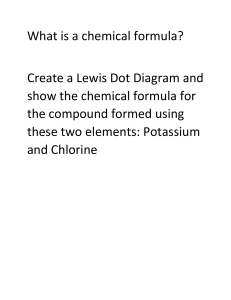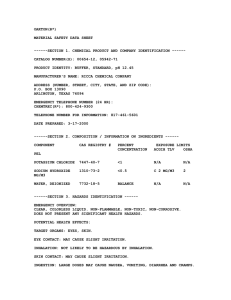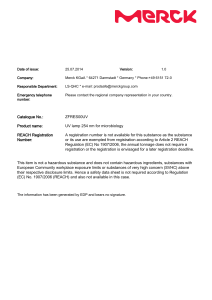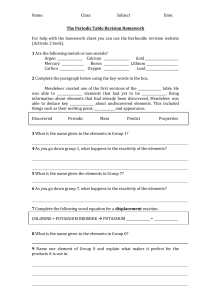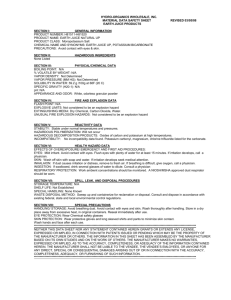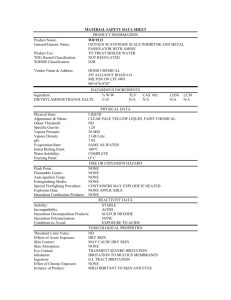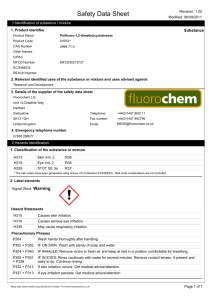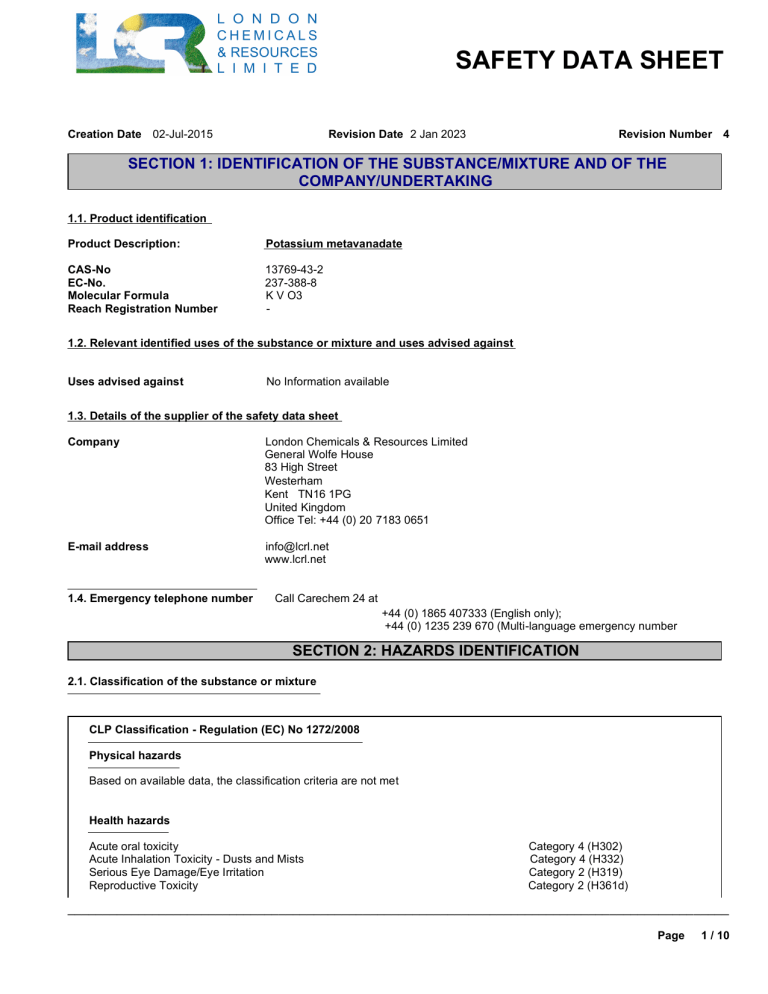
SAFETY DATA SHEET Revision Date 2 Jan 2023 Creation Date 02-Jul-2015 Revision Number 4 SECTION 1: IDENTIFICATION OF THE SUBSTANCE/MIXTURE AND OF THE COMPANY/UNDERTAKING 1.1. Product identification Product Description: Potassium metavanadate CAS-No EC-No. Molecular Formula Reach Registration Number 13769-43-2 237-388-8 K V O3 - 1.2. Relevant identified uses of the substance or mixture and uses advised against Uses advised against No Information available 1.3. Details of the supplier of the safety data sheet Company London Chemicals & Resources Limited General Wolfe House 83 High Street Westerham Kent TN16 1PG United Kingdom Office Tel: +44 (0) 20 7183 0651 E-mail address info@lcrl.net www.lcrl.net 1.4. Emergency telephone number Call Carechem 24 at +44 (0) 1865 407333 (English only); +44 (0) 1235 239 670 (Multi-language emergency number SECTION 2: HAZARDS IDENTIFICATION 2.1. Classification of the substance or mixture CLP Classification - Regulation (EC) No 1272/2008 Physical hazards Based on available data, the classification criteria are not met Health hazards Acute oral toxicity Acute Inhalation Toxicity - Dusts and Mists Serious Eye Damage/Eye Irritation Reproductive Toxicity Category 4 (H302) Category 4 (H332) Category 2 (H319) Category 2 (H361d) ______________________________________________________________________________________________ Page 1 / 10 SAFETY DATA SHEET Potassium metavanadate Revision Date 6 Aug 2020 ______________________________________________________________________________________________ Specific target organ toxicity - (repeated exposure) Category 1 (H372) Environmental hazards Chronic aquatic toxicity Category 2 (H411) 2.2. Label elements Signal Word Danger Hazard Statements H302 - Harmful if swallowed H332 - Harmful if inhaled H319 - Causes serious eye irritation H361d - Suspected of damaging the unborn child H372 - Causes damage to organs through prolonged or repeated exposure H411 - Toxic to aquatic life with long lasting effects Precautionary Statements P301 + P330 + P331 - IF SWALLOWED: rinse mouth. Do NOT induce vomiting P312 - Call a POISON CENTER or doctor/ physician if you feel unwell P264 - Wash face, hands and any exposed skin thoroughly after handling P304 + P340 - IF INHALED: Remove to fresh air and keep at rest in a position comfortable for breathing P337 + P313 - If eye irritation persists: Get medical advice/ attention P280 - Wear protective gloves/ protective clothing/ eye protection/ face protection 2.3. Other hazards No information available SECTION 3: COMPOSITION/INFORMATION ON INGREDIENTS 3.1. Substances Component CAS-No EC-No. Weight % Potassium metavanadate 13769-43-2 EEC No. 237-388-8 >95 Reach Registration Number CLP Classification - Regulation (EC) No 1272/2008 Acute Tox. 4 (H302) Acute Tox. 4 (H332) Skin Irrit. 2 (H319) Repr. 2 (H361d) STOT RE 1 (H372) Aquatic Chronic 2 (H411) - ______________________________________________________________________________________________ Page 2 / 10 SAFETY DATA SHEET Potassium metavanadate Revision Date 6 Aug 2020 ______________________________________________________________________________________________ Full text of Hazard Statements: see section 16 SECTION 4: FIRST AID MEASURES 4.1. Description of first aid measures General Advice If symptoms persist, call a physician. Eye Contact Rinse immediately with plenty of water, also under the eyelids, for at least 15 minutes. Get medical attention. Skin Contact Wash off immediately with plenty of water for at least 15 minutes. If skin irritation persists, call a physician. Ingestion Clean mouth with water and drink afterwards plenty of water. Get medical attention if symptoms occur. Inhalation Move to fresh air. If not breathing, give artificial respiration. Get medical attention if symptoms occur. Self-Protection of the First Aider Ensure that medical personnel are aware of the material(s) involved, take precautions to protect themselves and prevent spread of contamination. 4.2. Most important symptoms and effects, both acute and delayed None reasonably foreseeable. 4.3. Indication of any immediate medical attention and special treatment needed Notes to Physician Treat symptomatically. SECTION 5: FIREFIGHTING MEASURES 5.1. Extinguishing media Suitable Extinguishing Media Use extinguishing measures that are appropriate to local circumstances and the surrounding environment. Use water spray, alcohol-resistant foam, dry chemical or carbon dioxide. Extinguishing media which must not be used for safety reasons No information available. 5.2. Special hazards arising from the substance or mixture Thermal decomposition can lead to release of irritating gases and vapors. Hazardous Combustion Products None under normal use conditions. 5.3. Advice for firefighters As in any fire, wear self-contained breathing apparatus pressure-demand, MSHA/NIOSH (approved or equivalent) and full protective gear. SECTION 6: ACCIDENTAL RELEASE MEASURES 6.1. Personal precautions, protective equipment and emergency procedures ______________________________________________________________________________________________ Page 3 / 10 SAFETY DATA SHEET Potassium metavanadate Revision Date 6 Aug 2020 ______________________________________________________________________________________________ Ensure adequate ventilation. Use personal protective equipment. Avoid dust formation. 6.2. Environmental precautions Do not flush into surface water or sanitary sewer system. 6.3. Methods and material for containment and cleaning up Sweep up or vacuum up spillage and collect in suitable container for disposal. Keep in suitable, closed containers for dispos al. 6.4. Reference to other sections Refer to protective measures listed in Sections 8 and 13. SECTION 7: HANDLING AND STORAGE 7.1. Precautions for safe handling Wear personal protective equipment. Ensure adequate ventilation. Do not get in eyes, on skin, or on clothing. Avoid ingestion and inhalation. Avoid dust formation. Hygiene Measures Handle in accordance with good industrial hygiene and safety practice. Keep away from food, drink and animal feeding stuffs. Do not eat, drink or smoke when using this product. Remove and wash contaminated clothing before re-use. Wash hands before breaks and at the end of workday. 7.2. Conditions for safe storage, including any incompatibilities Keep container tightly closed in a dry and well-ventilated place. 7.3. Specific end use(s) Use in laboratories SECTION 8: EXPOSURE CONTROLS/PERSONAL PROTECTION 8.1. Control parameters Exposure limits List source(s): Component Potassium metavanadate Italy Germany TWA: 0.005 mg/m3 (8 Stunden). AGW exposure factor 1 TWA: 0.03 mg/m3 (8 Stunden). AGW exposure factor 1 Portugal The Netherlands Finland Biological limit values This product, as supplied, does not contain any hazardous materials with biological limits established by the region specific ______________________________________________________________________________________________ Page 4 / 10 SAFETY DATA SHEET Potassium metavanadate Revision Date 6 Aug 2020 ______________________________________________________________________________________________ regulatory bodies Monitoring methods BS EN 14042:2003 Title Identifier: Workplace atmospheres. Guide for the application and use of procedures for the assessment of exposure to chemical and biological agents. MDHS14/3 General methods for sampling and gravimetric analysis of respirable and inhalable dust Derived No Effect Level (DNEL) Route of exposure No information available Acute effects (local) Acute effects (systemic) Chronic effects (local) Chronic effects (systemic) Oral Dermal Inhalation Predicted No Effect Concentration (PNEC) No information available. 8.2. Exposure controls Engineering Measures Ensure that eyewash stations and safety showers are close to the workstation location. Wherever possible, engineering control measures such as the isolation or enclosure of the process, the introduction of proces s or equipment changes to minimise release or contact, and the use of properly designed ventilation systems, should be adopted to control hazardous materials at source Personal protective equipment Eye Protection Hand Protection Goggles (European standard - EN 166) Protective gloves Glove material Breakthrough time Glove thickness Natural rubber See manufacturers Nitrile rubber recommendations Neoprene PVC Skin and body protection Long sleeved clothing EU standard EN 374 Glove comments (minimum requirement) Inspect gloves before use. observe the instructions regarding permeability and breakthrough time which are provided by the supplier of the gloves. (Refer to manufacturer/supplier for information) gloves are suitable for the task: Chemical compatability, Dexterity, Operational conditions, User susceptibility, e.g. sensitisation effects, also take into consideration the specific local conditions under which the product is used, such as the danger of cuts, abrasion. gloves with care avoiding skin contaminatio n. Respiratory Protection When workers are facing concentrations above the exposure limit they must use appropriate certified respirators. To protect the wearer, respiratory protective equipment must be the correct fit and be used and maintained properly Large scale/emergency use Use a NIOSH/MSHA or European Standard EN 136 approved respirator if exposure limits are exceeded or if irritation or other symptoms are experienced Recommended Filter type: Particulates filter conforming to EN 143 Small scale/Laboratory use Use a NIOSH/MSHA or European Standard EN 149:2001 approved respirator if exposure limits are exceeded or if irritation or other symptoms are experienced. Recommended half mask:- Particle filtering: EN149:2001 When RPE is used a face piece Fit Test should be conducted ______________________________________________________________________________________________ Page 5 / 10 SAFETY DATA SHEET Potassium metavanadate Revision Date 6 Aug 2020 ______________________________________________________________________________________________ Environmental exposure controls Prevent product from entering drains. Do not allow material to contaminate ground water system. SECTION 9: PHYSICAL AND CHEMICAL PROPERTIES 9.1. Information on basic physical and chemical properties Appearance Physical State White Solid Powder Odor Odor Threshold pH Melting Point/Range Softening Point Boiling Point/Range Flash Point Evaporation Rate Flammability (solid,gas) Explosion Limits Odorless No data available No information available 500 - 600 °C / 932 - 1112 °F No data available No information available No information available Method - No information available Not applicable Solid No information available No data available Vapor Pressure No data available Vapor Density Not applicable Specific Gravity / Density No data available Bulk Density No data available Water Solubility No information available Solubility in other solvents No information available Partition Coefficient (n-octanol/water) Autoignition Temperature Not applicable Decomposition Temperature No data available Viscosity Not applicable Explosive Properties No information available Oxidizing Properties No information available Solid Solid 9.2. Other information Molecular Formula Molecular Weight K V O3 138.04 SECTION 10: STABILITY AND REACTIVITY 10.1. Reactivity None known, based on information available 10.2. Chemical stability Stable under normal conditions. 10.3. Possibility of hazardous reactions Hazardous Polymerization Hazardous Reactions No information available. None under normal processing. 10.4. Conditions to avoid Incompatible products. Excess heat. 10.5. Incompatible materials None known. ______________________________________________________________________________________________ Page 6 / 10 SAFETY DATA SHEET Potassium metavanadate Revision Date 6 Aug 2020 ______________________________________________________________________________________________ 10.6. Hazardous decomposition products None under normal use conditions. SECTION 11: TOXICOLOGICAL INFORMATION 11.1. Information on toxicological effects Product Information (a) acute toxicity; Oral Dermal Inhalation Category 4 Based on available data, the classification criteria are not met Category 4 Component Potassium metavanadate LD50 Oral 323 mg/kg ( Rat ) (b) skin corrosion/irritation; No data available (c) serious eye damage/irritation; Category 2 LD50 Dermal >2.5 g/kg ( Rat ) LC50 Inhalation 2.89 mg/L 4h ( Rat ) (d) respiratory or skin sensitization; Respiratory No data available Skin No data available (e) germ cell mutagenicity; No data available (f) carcinogenicity; No data available There are no known carcinogenic chemicals in this product (g) reproductive toxicity; Reproductive Effects Category 2 May cause harm to the unborn child. (h) STOT-single exposure; No data available (i) STOT-repeated exposure; Category 1 Target Organs (j) aspiration hazard; No information available. Not applicable Solid Symptoms / effects,both acute and No information available delayed SECTION 12: ECOLOGICAL INFORMATION 12.1. Toxicity Ecotoxicity effects Toxic to aquatic organisms, may cause long-term adverse effects in the aquatic environment. The product contains following substances which are hazardous for the ______________________________________________________________________________________________ Page 7 / 10 SAFETY DATA SHEET Potassium metavanadate Revision Date 6 Aug 2020 ______________________________________________________________________________________________ environment. 12.2. Persistence and degradability Degradability Degradation in sewage treatment plant No information available Not relevant for inorganic substances. Contains substances known to be hazardous to the environment or not degradable in waste water treatment plants. 12.3. Bioaccumulative potential No information available 12.4. Mobility in soil No information available 12.5. Results of PBT and vPvB assessment No data available for assessment. 12.6. Other adverse effects Endocrine Disruptor Information Persistent Organic Pollutant Ozone Depletion Potential This product does not contain any known or suspected endocrine disruptors This product does not contain any known or suspected substance This product does not contain any known or suspected substance SECTION 13: DISPOSAL CONSIDERATIONS 13.1. Waste treatment methods Waste from Residues / Unused Products Waste is classified as hazardous. Dispose of in accordance with the European Directives on waste and hazardous waste. Dispose of in accordance with local regulations. Contaminated Packaging Dispose of this container to hazardous or special waste collection point. European Waste Catalogue (EWC) According to the European Waste Catalogue, Waste Codes are not product specific, but application specific. Do not dispose of waste into sewer. Waste codes should be assigned by the user based on the application for which the product was used. Do not empty into drains. Do not let this chemical enter the environment. Other Information SECTION 14: TRANSPORT INFORMATION IMDG/IMO 14.1. UN number 14.2. UN proper shipping name 14.3. Transport hazard class(es) 14.4. Packing group UN2864 POTASSIUM METAVANADATE 6.1 II ADR 14.1. UN number 14.2. UN proper shipping name 14.3. Transport hazard class(es) 14.4. Packing group UN2864 POTASSIUM METAVANADATE 6.1 II IATA 14.1. UN number UN2864 ______________________________________________________________________________________________ Page 8 / 10 SAFETY DATA SHEET Potassium metavanadate Revision Date 6 Aug 2020 ______________________________________________________________________________________________ 14.2. UN proper shipping name 14.3. Transport hazard class(es) 14.4. Packing group POTASSIUM METAVANADATE 6.1 II 14.5. Environmental hazards Dangerous for the environment Product is a marine pollutant according to the criteria set by IMDG/IMO 14.6. Special precautions for user No special precautions required 14.7. Transport in bulk according to Not applicable, packaged goods Annex II of MARPOL73/78 and the IBC Code SECTION 15: REGULATORY INFORMATION 15.1. Safety, health and environmental regulations/legislation specific for the substance or mixture International Inventories Component Potassium metavanadate X = listed. EINECS 237-388-8 ELINCS - NLP TSCA X DSL X NDSL - PICCS X ENCS X IECSC X AICS - KECL KE-2922 9 National Regulations Component Potassium metavanadate Germany - Water Classification (VwVwS) WGK 3 Germany - TA-Luft Class Take note of Control of Substances Hazardous to Health Regulations (COSHH) 2002 and 2005 Amendment. Take note of Dir 94/33/EC on the protection of young people at work Take note of Dir 92/85/EC on the protection of pregnant and breastfeeding women at work 15.2. Chemical safety assessment A Chemical Safety Assessment/Report (CSA/CSR) has not been conducted SECTION 16: OTHER INFORMATION Full text of H-Statements referred to under sections 2 and 3 H302 - Harmful if swallowed H332 - Harmful if inhaled H319 - Causes serious eye irritation H361d - Suspected of damaging the unborn child H372 - Causes damage to organs through prolonged or repeated exposure H411 - Toxic to aquatic life with long lasting effects Legend CAS - Chemical Abstracts Service TSCA - United States Toxic Substances Control Act Section 8(b) Inventory EINECS/ELINCS - European Inventory of Existing Commercial Chemical DSL/NDSL - Canadian Domestic Substances List/Non-Domestic Substances/EU List of Notified Chemical Substances Substances List PICCS - Philippines Inventory of Chemicals and Chemical Substances ENCS - Japanese Existing and New Chemical Substances IECSC - Chinese Inventory of Existing Chemical Substances AICS - Australian Inventory of Chemical Substances KECL - Korean Existing and Evaluated Chemical Substances NZIoC - New Zealand Inventory of Chemicals ______________________________________________________________________________________________ Page 9 / 10 SAFETY DATA SHEET Potassium metavanadate Revision Date 6 Aug 2020` ______________________________________________________________________________________________ WEL - Workplace Exposure Limit ACGIH - American Conference of Governmental Industrial Hygienists DNEL - Derived No Effect Level RPE - Respiratory Protective Equipment LC50 - Lethal Concentration 50% NOEC - No Observed Effect Concentration PBT - Persistent, Bioaccumulative, Toxic TWA - Time Weighted Average IARC - International Agency for Research on Cancer PNEC - Predicted No Effect Concentration LD50 - Lethal Dose 50% EC50 - Effective Concentration 50% POW - Partition coefficient Octanol:Water vPvB - very Persistent, very Bioaccumulative ADR - European Agreement Concerning the International Carriage of Dangerous Goods by Road IMO/IMDG - International Maritime Organization/International Maritime Dangerous Goods Code OECD - Organisation for Economic Co-operation and Development BCF - Bioconcentration factor ICAO/IATA - International Civil Aviation Organization/International Air Transport Association MARPOL - International Convention for the Prevention of Pollution from Ships ATE - Acute Toxicity Estimate VOC - Volatile Organic Compounds Key literature references and sources for data Suppliers safety data sheet, Chemadvisor - LOLI, Merck index, RTECS Training Advice Chemical hazard awareness training, incorporating labelling, Safety Data Sheets (SDS), Personal Protective Equipment (PPE) and hygiene. Use of personal protective equipment, covering appropriate selection, compatibility, breakthrough thresholds, care, maintenance, fit and standards. First aid for chemical exposure, including the use of eye wash and safety showers. Prepared By Creation Date Revision Date Revision Summary Health, Safety and Environmental Department 02-Jul-2015 03-Mar-2019 SDS authoring systems update, replaces ChemGes SDS No. 13769-43-2/2. This safety data sheet complies with the requirements of Regulation (EC) No. 1907/2006 Disclaimer The information provided in this Safety Data Sheet is correct to the best of our knowledge, information and belief at the date of its publication. The information given is designed only as a guidance for safe handling, use, processing, storage, transportation, disposal and release and is not to be considered a warranty or quality specification. The information relates only to the specific material designated and may not be valid for such material used in combination with any other materials or in any process, unless specified in the text End of Safety Data Sheet ______________________________________________________________________________________________ Page 10 / 10
